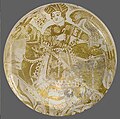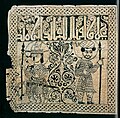Portal:Fatimid Caliphate
Introduction
The
Between 902 and 909 the foundation of the Fatimid state was realized under the leadership of
Selected articles
-
Zirids until 1057, when it was destroyed by the invading Banu Hilal tribes. Any useful objects or relics were scavenged during the centuries that followed. Today, only faint traces remain. (Full article...)
-
TheJaʽfari school of jurisprudence. The Aga Khan, currently Aga Khan IV, is the spiritual leader and Imam of the Nizaris. The global seat of the Ismaili Imamate is in Lisbon, Portugal. (Full article...)
-
The )
-
Abu Muhammad al-Hasan al-Yazuri (or al-Husayn) ibn Ali ibn Abd al-Rahman (died 1058) was a vizier of the Fatimid Caliphate, holding office from 1050 to 1058. (Full article...)
-
Full article...)
-
Abu Ali al-Mansur (Musta'lis, in addition to 2 million Druze.)
Histories of al-Hakim can prove controversial, as diverse views of his life and legacy exist. Historian Paul Walker writes "Ultimately, both views of him, the mad and despotic tyrant (like Germanic and Roman despots) irrationally given to killing those around him on a whim, and the ideal supreme ruler, divinely ordained and chosen, whose every action was just and righteous, were to persist, the one among his enemies and those who rebelled against him, and the other in the hearts of true believers, who, while perhaps perplexed by events, nonetheless remained avidly loyal to him to the end."critics misname him as "Nero of Egypt". (Full article... -
The Great Palaces of the Fatimid Caliphs (or Great Fatimid Palaces, among other name variants) were a vast and lavish palace complex built in the late 10th century in Cairo, Egypt, to house the Fatimid caliphs, their households, and the administration of their state. There were two main palace complexes, the Eastern and the Western Palace. They were located in the center of the walled city of Cairo around the area still known today as Bayn al-Qasrayn ("Between the Two Palaces"). (Full article...)
-
)
-
Abū'l-Futūh Barjawānal-Ustādh (عَبْدُ الْفُتُوحِ بَرْجَوَانِ الْأُسْتَاذِ; died 25/26 March 1000) was a eunuch palace official who became the prime minister (wāsiṭa) and de facto regent of the Shia Fatimid Caliphate in October 997, and held the position until his assassination. Of obscure origin, Barjawan became the tutor of heir-apparent al-Hakim bi-Amr Allah, who became caliph in 996 with the death of al-Aziz Billah. On al-Hakim's coronation, power was seized by the Kutama Berbers, who tried to monopolize government and clashed with their rivals, the Turkic slave-soldiers. Allied with disaffected Berber leaders, Barjawan was able to seize the reins of government for himself in 997. His tenure was marked by a successful balancing act between the Berbers and the Turks, as well as the rise of men of diverse backgrounds, promoted under his patronage. Militarily, Barjawan was successful in restoring order to the Fatimids' restive Levantine and Libyan provinces, and set the stage for an enduring truce with the Byzantine Empire. The concentration of power in his hands and his overbearing attitude alienated al-Hakim, however, who ordered him assassinated and thereafter assumed the governance of the caliphate himself. (Full article...)
-
Asad ad-Dīn Shīrkūh bin Shādhī (Kurdish) (died 22 February 1169) was a military commander in service of the Zengid dynasty, and uncle of Saladin. His military and diplomatic efforts in Egypt were a key factor in establishing the Ayyubid dynasty in that country. (Full article...)
-
Byzantine troops. Bakjur then became governor of Damascus for the Fatimids until 988. He made a last attempt to capture Aleppo in 991, which again was defeated thanks to Byzantine assistance. Bakjur was captured by Sa'd al-Dawla and executed. (Full article...)
-
Berber-dominated regime of the early years of al-Hakim (r. 996–1021), but was defeated and died in captivity. (Full article...)
-
Isma'ili historian. His work is fundamental for the history of the Fatimid Caliphate and the Isma'ili communities in Yemen. (Full article...)
-
al-Mansur, and al-Mu'izz. His reputation during his lifetime was considerable, and he was highly regarded by later critics. However, possibly due to his pro-Shi'a partisanship, which may have led to an attempted damnatio memoriae after the Zirid dynasty turned to Sunni Islam, or due to shifting literary tastes, none of his works survives in complete form. His work survives mostly in fragments that were appreciated and gathered together by later anthologists for their vivid and evocative language, such as descriptions of the Fatimid navy, a galloping horse, or the so-called Lake Palace in the palace city of Mansuriya. The only evidently pro-Shi'a works surviving are a eulogy for al-Mansur, and a moving description of the end of the famous anti-Fatimid rebel Abu Yazid. Al-Iyadi died in 976, probably in Cairo, where he had followed the Fatimid court following the Fatimid conquest of Egypt in 969. (Full article...)
-
The siege of Ascalon took place in 1153, resulting in the capture of that Egyptian fortress by the Kingdom of Jerusalem. (Full article...)
-
Barqa. His collected documents and letters were published after his death by his secretary as the Sirat al-Ustadh Jawdhar, and form one of the main historical sources for the governance of the Fatimid state in the period. (Full article...)
-
Caliph al-Zafir from 1149 to 1154. A capable and brave soldier, Ibn al-Sallar assumed senior gubernatorial positions, culminating in the governorship of Alexandria. From this position in 1149 he launched a revolt, along with his stepson Abbas ibn Abi al-Futuh. Defeating the army of the then vizier, Ibn Masal, he occupied Cairo and forced the young Caliph al-Zafir to appoint him vizier instead. A mutual disdain and hatred bound the two men thereafter, and the Caliph even conspired to have Ibn al-Sallar assassinated. During this tenure, Ibn al-Sallar restored order in the army and strove to halt Crusader attacks on Egypt, but with limited success. He was assassinated at the behest of his ambitious stepson Abbas, who succeeded him as vizier. (Full article...)
-
Ridwan and held the city, under the suzerainty of the Fatimid Caliphate, until his assassination by the Assassins. (Full article...)
-
al-Tayyib.)
The Hafizi sect lost state backing and gradually disappeared after the abolishment of the Fatimid Caliphate in 1171 and the conquest of the Fatimid-aligned dynasties of Yemen by the Ayyubid dynasty shortly after. The last remnants of the Hafizi branch are attested in the 14th century in Egypt and Syria, but had died out by the 15th century. (Full article... -
Full article...)
-
the Twelve Imams who were guides and a light to God. (Full article...)
-
Amalric I of Jerusalem. Shawar was notorious for continually switching alliances, allying first with one side, and then the other, and even ordering the burning of his own capital city, Fustat, just so that the enemy could not have it. (Full article...)
-
The Fatimid architecture that developed in the Fatimid Caliphate (909–1167 CE) of North Africa combined elements of eastern and western architecture, drawing on Abbasid architecture, Byzantine, Ancient Egyptian, Coptic architecture and North African traditions; it bridged early Islamic styles and the medieval architecture of the Mamluks of Egypt, introducing many innovations.
The wealth of Fatimid architecture was found in the main cities of Mahdia (921–948), Al-Mansuriya (948–973) and Cairo (973–1169). The heartland of architectural activity and expression during Fatimid rule was at al-Qahira (Cairo), on the eastern side of the Nile, where many of the palaces, mosques and other buildings were built. Large-scale constructions were undertaken during the reigns of al-Mui'zz (r. 953–975) Al-Aziz Billah (r. 975–996) and al-Hakim (r. 996–1021). (Full article...) -
at-Tayyib Abu'l-Qasim to the Imamate. (Full article...)
-
TheFull article...)
Did you know...
- ... that the last Fatimid caliph, al-Adid, came to the throne as a child, was dominated by his viziers, and died a few days after Saladin abolished the Fatimid regime?
- ... that Qadi al-Fadil began his career under the Fatimids, became Saladin's chief minister, and was renowned for the elegance of his epistolary writing?
- ... that the memoirs of the eunuch chamberlain Jawdhar are one of the most important sources on the history of the Fatimid Caliphate in the mid–10th century?
- ... that Abd al-Rahim ibn Ilyas, heir apparent of the Fatimid Caliphate, was arrested after the caliph's death and died in captivity under unclear circumstances?
Need help?
Do you have a question about the Fatimid Caliphate that you can't find the answer to?
Consider asking it at the Wikipedia reference desk or at the talk page of WikiProject Islam.
If you are interested in reading more about the Fatimid caliphate, some up-to-date summary books and encyclopedia articles are:
- Brett, Michael (2017). The Fatimid Empire. The Edinburgh History of the Islamic Empires. Edinburgh: Edinburgh University Press. ISBN 978-0-7486-4076-8.
- ISBN 978-0-933273-32-0.
- ISSN 1873-9830.
- Sanders, Paula (1998). "The Fāṭimid state, 969–1171". In Petry, Carl F. (ed.). The Cambridge History of Egypt, Volume 1: Islamic Egypt, 640–1517. Cambridge: Cambridge University Press. pp. 151–174. ISBN 0-521-47137-0.
- Walker, Paul E. (1998). "The Ismā'īlī Da'wa and the Fātimid caliphate". In Petry, Carl F. (ed.). The Cambridge History of Egypt, Volume 1: Islamic Egypt, 640–1517. Cambridge: Cambridge University Press. pp. 120–150. ISBN 0-521-47137-0.
- Walker, Paul E. (2018). "Fāṭimids". In ISSN 1875-9831.
Selected images
-
Map of Abu Abdallah's campaigns and battles during the overthrow of the Aghlabids (from Fatimid Caliphate)
-
Fatimid gold dinar minted during the reign of al-Mustansir Billah (1036–1094) (from Fatimid Caliphate)
-
Fatimid Caliphal-Mahdi Billah receiving an envoy from Simeon I of Bulgaria, Madrid Skylitzes, 12th century. (from Fatimid Caliphate)
-
Al-Salih Tala'i Mosque in Cairo, built by Tala'i ibn Ruzzik in 1160 and originally intended to house the head of Husayn (the head ended up being interred instead at the present-day al-Hussein Mosque) (from Fatimid Caliphate)
-
Fatimid horseman on a plate, 12th century CE. (from Fatimid Caliphate)
-
The Al-Hakim Mosque in Cairo, commissioned by al-Aziz in 990 and completed by al-Hakim in 1013 (later renovated in the 1980s by the Dawoodi Bohra) (from Fatimid Caliphate)
-
Cover page of the Leningrad Codex, a manuscript of the Hebrew Bible copied in Cairo/Fustat in the early 11th century (from Fatimid Caliphate)
-
Fragments of mosaic pavement from the palace of al-Qa'im in al-Mahdiyya (Mahdia), on display at the Mahdia Museum (from Fatimid Caliphate)
-
Architectural fragment from a bathhouse inal-Fustat, 11th century CE (pre-1168 CE). Museum of Islamic Art, Cairo, 12880. (from Fatimid Caliphate)
-
al-Fustat, and it was likely an important production location for Islamic ceramics during the Fatimid period. (from Fatimid Caliphate)
-
Entrance portal of the Great Mosque of Mahdia (10th century) (from Fatimid Caliphate)
-
Side chapel in the Hanging Church in Old Cairo, including frescoes (partly visible behind the screen here) dating from the late 12th or 13th century, before the church's later renovation (from Fatimid Caliphate)
-
Image of two standing soldiers. 11th century, Fatimid period, from Fustat near Cairo. Museum of Islamic Art, Cairo, inv. no. 13703. Attribution to the Fatimid period is sometimes questioned. (from Fatimid Caliphate)
-
Men hunting, on ivory panel, 11th century (from Fatimid Caliphate)
-
Bab al-Futuh, one of the gates of Cairo dating from Badr al-Jamali's reconstruction of the city walls (1987) (from Fatimid Caliphate)
Subcategories
Subtopics
Associated Wikimedia
The following Wikimedia Foundation sister projects provide more on this subject:
-
Commons
Free media repository -
Wikibooks
Free textbooks and manuals -
Wikidata
Free knowledge base -
Wikinews
Free-content news -
Wikiquote
Collection of quotations -
Wikisource
Free-content library -
Wikiversity
Free learning tools -
Wiktionary
Dictionary and thesaurus




























